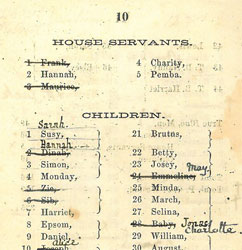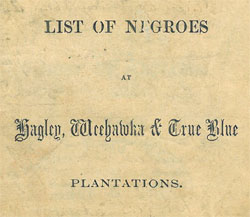by David Faulds, Rare Book Librarian, dfaulds [at] emory [dot] edu
A bibliographical mystery in MARBL's rare book collection is a small eleven page pamphlet, published in 1860, titled List of Negroes at Hagley, Weehawka & True Blue Plantations. The text is an inventory of slaves with the name of the plantation followed by the name of the plantation owner and the names of the individual slaves, divided into men, women and children with “House servants” being a separate category for True Blue plantation.
Hagley and Weehawka plantations, located in Georgetown County, S.C., were owned by Plowden C.J. Weston (1819 or 20-1864) while True Blue plantation, in Beaufort County, S.C., was owned by his father, Francis Marion Weston. Hagley and Weehawka were both rice plantations while True Blue produced both rice and indigo. Hagley is listed as having 10 male and 7 female slaves, Weehawka has 41 male and 50 female slaves with 71 children while True Blue has 49 male and 56 female slaves with 5 house servants and 46 children.

Page from List of Negroes at Hagley,
Weehawka and True Blue Plantations,
1860
The puzzle is in why this inventory was printed in the first place. It was printed in Charleston, S.C. by the large firm of Walker, Evans & Co., presumably for Plowden C.J. Weston. Normally a handwritten ledger would be the appropriate way to record slave holdings. With such a large number of slaves, births and deaths would quickly render the printed document out of date. Perhaps the printed inventory was a means to demonstrate wealth to others or was the date of printing on the eve of the Civil War a factor?
This little publication becomes even more interesting as the text was annotated by hand in 1864 to record changes to the slave population at each plantation. Again, why annotate this small printed inventory when a large ledger book would be more practical and customary? We will likely never know but the resulting document is a fascinating record of the slave holdings of three South Carolina plantations during the Civil War.
Today, the Hagley and Weehawka plantations are housing subdivisions while the True Blue plantation is a notable golf course.


To be more accurate, True Blue Plantation and Midway Plantation, the plantation that once shared True Blue’s northern border, now make up Heritage Plantation, an exclusive gated community and golf course.
Hagley and Weehawka Plantations, now generally known as Hagley, is also subdivided, although not with the restrictions of neighboring Heritage. Hagley is also home to a golf course that is a local favorite.